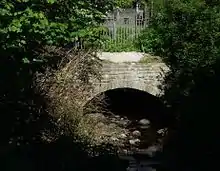Rassa Railroad
The Rassa Railroad was a horse-drawn tramroad in south Wales, running between Sirhowy Ironworks and Beaufort Ironworks, with connections also to the Trefil Rail Road and the Ebbw Vale Ironworks. It was later served with a tram engine.
History

The Rassa Railroad opened in 1794 as an edge railway of approximately 3 ft 4 in (1,016 mm) gauge.[1]: p.57 It was laid out by Thomas Dadford, engineer of the Monmouthshire Canal Co., which owned the line.[1]: p.201 After a few years it was converted to a 4 ft 2 in (1,270 mm) gauge plateway.[1]: p.201 A tram engine was used on the route from 1829.[1]: p.201 At some point the owner of the Rhymney Ironworks also secured running rights over the Rassa line.[1]: p.213
Route
The railway ran for 2.5 miles (4.0 km), directly north from Sirhowy then east through the village of Rassau to Beaufort. At Trevil Machine (location of a weighing machine), where the line turned sharply to the east,[2] a junction was made with the Trefil Rail Road from the limestone quarries at Trefil. A further junction with the Trefil line at Shop Row led to the Ebbw Vale Ironworks at Pont-y-Gof.[1]: p.201 [3][4] There was at least one viaduct.[2] Sirhowy was also served by the Sirhowy continuation of the Nine Mile Point Tramroad.[1]: p.200
The recommended carrying weight was up to 45 hundredweight per set of wheels, but loadings of up to 3 tons of iron were noted.[1]: p.81 Other materials carried included coal and limestone.[1]: p.201
Today
The former tramroad lies within Blaenau Gwent,[4] now passing communities such as Rassau, Carmeltown and Glyncoed. The former tramroad permanent way is represented now by areas of tarmac and pathways. There is at least one surviving stone bridge.[2]
References
- Baxter, Bertram (1966). Stone blocks and Iron Rails. The Industrial Archaeology of the British Isles. Newton Abbot, Devon: David and Charles.
- "The Trefil Tramroad and Railway". Industrial Gwent. Retrieved 29 March 2020.
- "Rassa Railroad". RailBrit.co.uk. Retrieved 29 March 2020.
- "Ebbw Vale history". bioeddie.co.uk. Retrieved 29 March 2020.
6